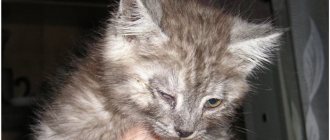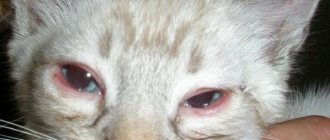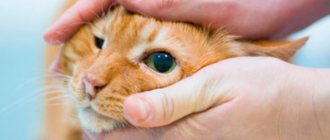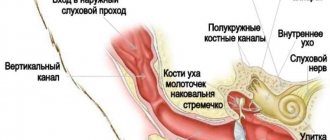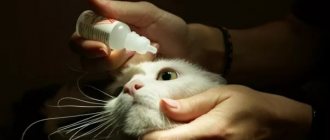If the animal is healthy, then liquid of a natural shade flows from under the eyelids. Sometimes the tissues around the eyes become inflamed, then it is already possible to talk about the presence of some pathology. In most cases, the disease is accompanied by lethargy, weakness, apathy, and loss of appetite. An attentive owner will immediately notice changes in the pet’s behavior.
Etiology of discharge
The norm is a transparent liquid, flowing secretion from the eyes. Excessive lacrimation is not noted as a deviation if provoked by dust, odorous substances, chemicals or smoke. Darkish, thick, strange-looking discharge should cause excitement.
Unusual discharge from a cat's eyes – causes:
- allergic reaction;
- inflammation of the lacrimal sac;
- mechanical damage;
- entry of a foreign body;
- diseases of the eye vessels;
- weakened immunity;
- development of helminthic infestation;
- inversion of eyelids, ingrown eyelashes;
- chronic diseases;
- keratitis, blepharitis, conjunctivitis.
Often the appearance of discharge is provoked by infectious diseases. Examples: calcivirosis, influenza, panleukopenia, rhinotracheitis, toxoplasmosis and chlamydia. Genetic predisposition plays a major role. Thus, British and Persian cat breeds are more likely to get sick.
Why do cats have lacrimation?
In cats, lacrimation from the eyes can be either natural or pathological. In the first case, nothing threatens the health of the pet and only careful care of the cat is required. Pathological lacrimation is very unsafe for the animal, as it can lead to loss of vision. In this case, veterinarian intervention is required.
With pathological lacrimation, a watery discharge of a coffee-colored, cloudy or transparent color appears on the cat’s eyes. In addition, it should be noted that such lacrimation causes unpleasant feelings in the pet: itching, the cat constantly rubs its eyes with its paws, becomes lethargic, its body temperature may rise, loss of appetite, and the eye itself may close and swell.
With pathologies, a cat may cry due to...
- Mechanical damage and injury . This is also called keratitis, or inflammation of the cornea. Foreign objects can get into the eye area and cause discomfort in the pet and develop an inflammatory process. Keratitis is accompanied by a fear of light in pets, discharge of pus from the eyes, and redness of the eye area. The cat's eye closes and tears may flow from it.
- Burn . In the home, any aggressive household chemical can cause a corneal burn. Cats are often curious, so if a cat becomes interested in cooking, it can get burned and start squinting.
- Allergic reaction . Not only people, but also animals are susceptible to various manifestations of allergies. Pets can be allergic to different things: new food, household chemicals, fluff, tobacco smoke, etc.
- Colds . If a cat has a cold, its reaction is often manifested by constant lacrimation. In this case, you should immediately consult a doctor.
- Conjunctivitis . Chlamydia, various bacteria, viruses, and fungi cause a similar infection. The eye may become red and fester. For conjunctivitis, as for colds, you should consult a veterinarian.
- Incorrect eyelash growth . Eyelashes grow incorrectly, causing discomfort to the animal. In this case, you should also contact your veterinarian.
- Glaucoma . Your pet has increased intracranial pressure due to injury or illness. Glaucoma leads to enlargement of the eye and decreased visual acuity. Also, owners may often notice that with glaucoma, the animal’s eye is swollen. In the later stages of this disease, blindness is possible without any treatment.
- Epiphora, or profuse lacrimation . The owner may notice that the pet is constantly crying. Epiphora can lead to partial or complete blockage of the nasolacrimal duct. An advanced form of this pathology can cause dermatitis.
- Parasites . In pets, not only the intestines can suffer, but also the organs of vision, because worms are also found there. They cause inflammation, severe lacrimation and pus.
Of course, if you find that your cat’s eye is watery and won’t open and there is one of the above signs, you need to contact a veterinarian.
Watery eyes can also occur due to natural causes.
- After sleep . In this case, the cat can remove the tears itself by washing, or you just need to wipe the eye area with boiled water.
- Long wool . It may get into the eye and cause irritation. Owners should regularly trim the fur on their pet's face and brush it regularly.
- Sphynx breed . Lacrimation is a feature of the body. Doctors often diagnose this breed with “entropion,” which means the lower and upper eyelids may roll up. In this case, only surgery will help the pet.
- Age . Excessive tearfulness is characteristic of kittens whose eyes have recently opened. Often, as the cat grows up, such profuse tearing stops. The owner can wipe the pet's eyes several times a day with a cotton swab dipped in warm boiled water to prevent the kitten's eyes from sticking together.
Symptoms
Often, pathological discharge from the eye is brown. This shows that the secretion has a purulent composition. The cause is a bacterial infection. Additionally, the sick animal experiences lethargy, rhinitis, and a runny nose. Eyes can fester due to a malfunction of the tear ducts.
Abundant and thick transparent secretion is an indicator of a viral infection. If the consistency is noted as watery, then most likely it is an allergy. A typical symptom is swelling of the eyes. A large number of tears flow out, but without pus. There are reddish stains, which are extremely difficult to notice. In this case, the cause is an injury or scratch.
What to do and how to treat?
Before visiting the doctor, you can wipe your pet’s eyes with a herbal decoction.
If the owners notice that the cat’s eyes are festering and other alarming symptoms are recorded, then they should not delay a visit to the veterinarian. At home, it is possible to treat the visual organs with decoctions based on chamomile, calendula and other medicinal herbs that have antimicrobial and antiseptic effects. After conducting a comprehensive examination and identifying the root cause of the problem, the pet is prescribed medications.
You should not apply any eye drops to cats for pus at your own discretion, since there is a high probability of worsening the disease and developing complications. In most cases, it is possible to cope with unpleasant symptoms in a pet with the help of the following ophthalmic medications:
- "Iris";
- "Leopard";
- "Diamond Eyes";
- "Levomycetin".
For a speedy recovery of your pet and elimination of pathological exudate, you need to know how to properly apply eye drops to a cat. To do this, the pet's head is fixed so that the visual organs are directed upward. It is better to perform the manipulation together to ensure reliable fixation of the cat. The pipette must be kept at a distance of 2 centimeters from the eye, so that in case of sudden movement it does not damage the mucous membrane of the eye. Treatment is carried out until the animal recovers completely, until the discharge completely stops appearing.
What to do if there is discharge from the eyes
First you need to take your pet to the vet. After examination and necessary tests, the doctor will make a diagnosis and determine treatment. If there is an infection, then antiviral and antibacterial drugs. Drops and ointments are also prescribed to relieve inflammation.
Other treatment options:
- if it is a foreign body, neoplasm – removal;
- in case of an allergic reaction - antihistamines;
- if necessary, physiotherapeutic treatment;
- problem with the kidneys, liver, gastrointestinal tract - targeted therapy.
Before visiting a veterinarian, it is allowed to alleviate the pet’s condition. You need to rinse your eyelids with light and gentle movements using a cotton pad. You can moisten with antiseptics without alcohol, saline. solution, infusion of chamomile or oak bark. It is impossible to start lacrimation with purulent discharge, as the risk of losing vision increases.
Methods for preventing eye diseases in cats
It is much easier to prevent eye disease in your pet than to treat it. Therefore, experts have developed a number of preventive actions, which include:
- examination of the animal’s visual organs after walking the animal (if it is walking);
- regular vaccination;
- special attention to animal hygiene;
- washing the eyes if wounds or foreign bodies are found in them;
- regular inspection by the owner of the cat’s fur, eyes and nose - if necessary, wipe the eyes with a cotton swab dipped in water;
- carrying out timely deworming;
- choosing high-quality pet food that contains a balanced amount of vitamins and minerals;
- timely contact a veterinarian.
Reasons for the appearance of a child
The inflammatory process on the conjunctiva can be provoked by:
- Viruses, including adenovirus and herpes. The disease lasts no more than 10 days, but can be complicated by bacterial infection.
- Infections – gonococci, streptococci, Pseudomonas aeruginosa, staphylococcus, fungi. The disease is severe, on average 2 weeks.
- A fungus that affects children with immunodeficiency.
- Chlamydia is an intermediate microorganism between viruses and bacteria.
- Improper hygiene, eye injuries with subsequent infection.
- Allergy – intolerance to certain substances, medications, products.
- Long-term inflammatory diseases of the nose, eyes, ears - tonsillitis, sinusitis, rhinitis.
Eye injury
Discharge from the eye can be caused by mechanical trauma. There are countless reasons. Mostly, pets often manage to scratch their eyes with their claws, but this can also happen after a fight with other cats.
A cat can also get an eye injury if it bumps into a foreign object, such as a thorny flowerpot. Take a closer look at the animal - when injured, the cat does not rub its face with its paws, as is the case with a clogged eyelid, but simply squints.
Please note that in case of any eye injury, you should immediately show the cat to an experienced veterinarian in order to avoid deterioration of vision or blindness of your beloved pet!
Diagnostic methods
Before treating conjunctivitis, it is necessary to identify what type of conjunctivitis is present in the child. To do this, first a history of the disease is collected, and then laboratory and ophthalmological examinations are prescribed:
- biomicroscopy of the eye;
- a smear from the conjunctiva followed by cytological examination in the laboratory;
- analysis for the level of IgE and eosinophils in the blood;
- skin allergy tests;
- tests for worms and dysbacteriosis;
- microscopic examination of tear fluid;
- bacteriological examination of discharged pus;
- scraping for enterobiasis.
If an allergic type of disease is suspected, the child is advised to consult an allergist, who will prescribe additional tests.
Allergies and parasites
The cause of lacrimation may lie in allergies. Yes, cats, like people, can be susceptible to allergic reactions to dust, food, flowering house plants, and even their own fur. If both eyes of a cat are watery, and he often sneezes and itches, then this may be a reaction to some allergen. In this case, a veterinarian must make a diagnosis to confirm the allergy.
By the way, allergies can be triggered by infection with helminths, the presence of which has a detrimental effect on the pet’s immunity. In Murmansk, you can contact the Favorit veterinary clinic for initial diagnosis, consultation with a veterinarian and purchase of anthelmintic drugs.
Prevention of conjunctivitis
To prevent the development of conjunctivitis in your cat, you should follow a number of measures. For example:
- Try to carry out annual vaccinations and regularly give anthelmintics, since viruses and helminths can be the root cause of the disease.
- Support your pet's immune system with immunomodulatory agents.
- Protect the cat from getting foreign bodies and chemicals into the eyes. Clean more often, handle hygiene products carefully, and put household chemicals away.
- Limit your pet's contact with other animals, especially stray and obviously sick ones.
- Wash and disinfect your hands thoroughly after contact with sick animals before interacting with your pet.
Thus, conjunctivitis in cats is not uncommon. However, there is nothing to worry about; with timely treatment, you can get rid of the disease once and for all.
How to cure a cat
In addition to treating the underlying disease, the symptom of which is increased secretion of the lacrimal glands and a change in their color, attention should be paid to the hygiene of the visual organs. You can remove black discharge from a cat’s eyes using solutions of furatsilin or boric acid. They will not only cleanse dirt, but also provide an antibacterial effect. Solutions can be replaced with strong tea, chamomile infusion or just warm water. In some cases, the cat is prescribed antibacterial drops.
© shutterstock

